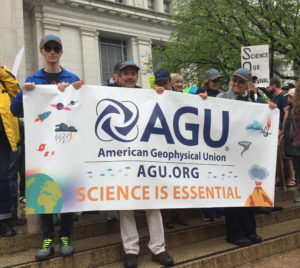March for Science: Reflections from AGU President Eric Davidson
Editor’s Note: This week, we’ll be sharing reflections on the March for Science from AGU leaders. This is part one of three. Part two and part three can be viewed here. 
My young adult son was at my side, holding the AGU banner as we participated in the March for Science in Washington, D.C. While I can remember other historic marches on Washington–for civil rights, protesting the Vietnam War, and the original Earth Day kickoff–I had the privilege this time to see this remarkable event, which motivated and was organized by scientists, through the lenses of both my own career in science and my son’s first impression of this form of democracy in action.
I was proud, very proud.
I was proud of the tens of thousands of scientists, from AGU and many other scientific societies and disciplines, who stepped outside their academic comfort zones to express their passion for the importance of science to improve the human condition. This was an unprecedented achievement of the scientific community, as noted by my favorite sign: “So bad, even the introverts are here!”
I was also proud of our democracy, which continues to serve and engage generations of citizens, now including citizen scientists and my son’s generation, to inform their elected representatives of what they value to be important. Another great sign was: “The oceans are rising and so are we!”
It is only natural that every elected leader will attempt to deliver on promises to core supporters, but in the U.S., our democratic process of checks and balances and freedom of speech ensures that we scientists, regardless of our party affiliation, or who we voted for, can have a say and an influence on issues pertaining to our core values. Doing so, however, requires that we no longer complacently sit back and assume that the rest of the world will understand how our science advances economic prosperity, national security, human health, and environmental sustainability. This message should resonate across the political spectrum, but it needs personal narratives, such as the sign: “Have Rubella? I don’t thanks to science!”
The M arch for Science was a watershed moment for science, where scientists and their allies across the world came together in common cause and purpose. I am also proud that, for the most part, the marches were conducted with a non-partisan, constructive tone, not against anything, but rather “for science,” reinforcing messages such as the AGU banner: “Science is Essential!”
arch for Science was a watershed moment for science, where scientists and their allies across the world came together in common cause and purpose. I am also proud that, for the most part, the marches were conducted with a non-partisan, constructive tone, not against anything, but rather “for science,” reinforcing messages such as the AGU banner: “Science is Essential!”
But now the real work begins – we must tell our stories over and over again, in ways that few of us have done before, until more and more people, like my son, step in to show their appreciation and support of the role of science for the betterment of humanity. Unlike many kinds of marchers and lobbyists, we are not a special interest group asking for special favors from government for predominantly selfish interests. Rather, we are a knowledge-generating and service-producing profession which, when entrusted with reasonable resources, pays rich dividends to those civil societies and governments that value science – which brings me to my own sign: “Investment in science pays!”
Editor’s Note:
- AGU has put together a five-week action plan with several easy ways you can speak up for science and keep the momentum from the March for Science going.
- Reach out and help build dialogue with your neighbors, community members, legislators, and others about science and its value by joining AGU’s Sharing Science Network
- Sign up for Science Policy Alerts or visit ScienceIsEssential.org for tips, tools and resources you can use to communicate the value of science.
- Watch this video about AGU’s presence at the March for Science nationally in D.C. and internationally in Vienna.




Eric,
Good article, appears balanced. It is good to remain as unbiased as possible. Your statement: “Unlike many kinds of marchers and lobbyists, we are not a special interest group asking for special favors from government for predominantly selfish interests.”, however is not truly unbiased. As a long term member of AGU (since 1970’s), I have worked with and observed a blindspot in academic & government scientists. As an early member of the AGU Development Committee’s creation, it was difficult for me as an “industry scientist” to present ideas that did not resonate with the AGU norm. Remember that academic/government scientists are often “fighting” to protect their programs, pet projects, and ideas. It appeared that opinions from industry were often ignored or called “biased”, while “of course we are unbiased”.
The best approach is to evaluate opinions, ideas, and thoughts on their merit to help the Earth, and our environment, on the whole while not pigeon-holing or excluding alternative concepts without consideration. As we move forward to provide leadership through the maze of climate change, adaptation and mitigation, lets not forget that infighting between groups for “turf”, as well as institutionalized redundancy and barriers will not help us lead by example nor determine good alternatives.
Thank you for providing a forum for open discussion
It is telling when even the most visible adherents to Anthropogenic climate change parse their words so vaguely as to bring doubt upon themselves. More insecurity from the global warming pseudo-scientists. Even Kevin Trenberth and Thomas Karl (formerly of NOAA) are part of the back-peddling. Note they even place “hiatus” in paratheses to relay the imprecision of this term. Quoting: ” There are a number of uncertainties and knowledge gaps regarding the “hiatus.” This report reviews these issues and also posits insights from a collective set of diverse information that helps us understand what we do and do not know. One salient insight is that the GMST phenomenon is a surface characteristic that does not represent a slowdown in warming of the climate system but rather is an energy redistribution within the oceans. Improved understanding of the ocean distribution and redistribution of heat will help better monitor Earth’s energy budget and its consequences. A review of recent scientific publications on the “hiatus” shows the difficulty and complexities in pinpointing “the oceanic sink of the “missing heat” from the atmosphere and the upper layer of the oceans, which defines the “hiatus.” Advances in “hiatus” research and outlooks (recommendations) are given in this report.” http://onlinelibrary.wiley.com/doi/10.1002/2016EF000417/full